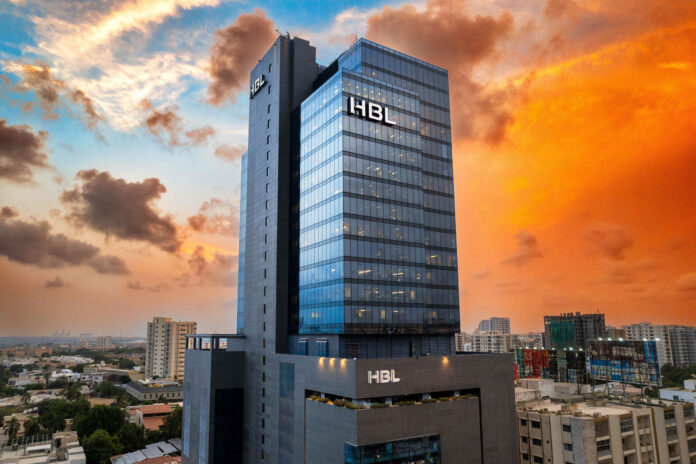Habib Bank Ltd has crossed a symbolic and strategically vital threshold: Rs5 trillion in deposits. By the end of June 2025, management told analysts the balance had climbed to Rs5.2 trillion, up sharply from Rs4.37 trillion at end-2024.
Two details make the feat more than cosmetic. First, the growth is fast – roughly a 19–22% leap in just half a year. Second, the mix improved: current accounts now comprise about 40.5% of the domestic deposit base, with management targeting 42% by year-end – a mix shift that lowers funding costs and hard-wires earnings resilience in a falling-rate cycle. The bank attributes the deposit acceleration to “whole-bank” execution rather than a handful of branches, and expects momentum to continue through 2H-2025.
The market backdrop helps, but the bank’s own P&L underscores how deposit depth is feeding through to performance. In 2Q-2025, total revenue rose to about Rs91.6 billion, up 13% year-on-year, led by mark-up income; EPS printed at Rs12.12 (up 24% YoY), and the bank announced a Rs4.5 per share dividend for the quarter, taking 1H-2025 payouts to Rs9 per share. Cost discipline is improving too: the cost-to-income ratio eased to ~49% during the half (domestic business already sub-50%), and management says it wants that trend to hold. Capital remains comfortably above requirements with a CAR near 17.9%.
These datapoints, summarised in the tables and briefing notes shared with analysts, frame the deposit milestone as the financial engine of an improving income statement rather than a vanity metric.
What is powering growth and profitability
The first and most obvious driver is the surge in current accounts. Current account growth was described as the highest ever, with roughly Rs440 billion added in 1H-2025 alone – moving the CA ratio from 37.3% in December to 40.5% in June. Cheap, sticky funding lowers blended liability costs and protects margins as policy rates move; management is explicit about pushing this mix to ~42% by year-end.
A second lever is how the bank has redeployed liquidity. Investments rose to ~Rs4.3 trillion by June, with an emphasis on floating-rate PIBs (about 51%), supplemented by fixed PIBs (22%) and T-bills (18%) – a positioning that preserves carry while keeping duration risk in check as the rate cycle evolves. Only a small portion of the fixed-rate book is due in the next 18 months, limiting reinvestment risk. This portfolio shape is laid out clearly in the corporate-briefing materials.
The cost-to-income ratio has drifted down to the high-40s domestically (55% to 55.2% at the group level), with management reiterating a sub-50% aspiration across the consolidated franchise. That is not just a cost story; it is also about scalability – expanding top-line through better use of an already-built network, technology, and processes.
The infection ratio edged down to ~5.0% by June, with coverage near 90%; 1H-2025 also benefitted from lower provisioning as IFRS-9 one-offs rolled off and recoveries improved. That combination – steady asset quality and less P&L drag from credit costs – supports both earnings and capital.
There is improvement in the microfinance arm too: Habib Microfinance Bank swung to a profit of ~Rs1 billion in 1H-2025 versus a loss a year earlier, a helpful catalyst for consolidated numbers and a signal that risk-adjusted pricing and cost control are biting.
Put together, HBL’s profit engine right now is textbook: more and cheaper deposits, earnings-friendly asset mix, contained credit costs, and incremental operating leverage – all underwritten by a strong capital cushion. The bank’s guidance remains deliberately cautious on rates and inflation, but the internal targets on deposit mix and costs suggest it is managing for margin stability even in a normalising rate environment.
A history of Pakistan’s flagship bank
Habib Bank traces its roots to 1941, when the Habib family established the bank in Bombay to serve the trading community of the subcontinent. At Partition in 1947, HBL moved its head office to Karachi and rapidly became the government’s principal banker, financing trade and reconstruction. Throughout the 1950s and 1960s it grew into the country’s largest commercial bank, with a widening international footprint as the diaspora spread out across the Gulf, Africa and the UK.
In 1974, Pakistan nationalised its banking sector. The Habib family, displaced from their flagship, went on to establish Habib Bank AG Zurich internationally and later Bank AL Habib domestically after financial liberalisation, keeping the Habib name present in global and local banking even as HBL itself remained state-owned.
In 2004, the government privatised HBL, with Aga Khan Fund for Economic Development (AKFED) leading the acquisition. The change unleashed heavy investment in governance, risk systems, and technology. Over the past two decades HBL has retained the country’s largest branch network and scaled up digital channels, corporate and investment banking, and payments. The present franchise now spans universal banking in Pakistan – from corporate and SME financing to consumer lending, payments, trade services, wealth management and agriculture – plus a selective international presence aligned to client needs and remittance corridors.
The Rs5.2 trillion deposit base underlines a bank built on sheer distribution and brand equity, but the current strategy leans as much on quality of deposits as on size. The medium-term playbook is clear in the analyst briefings: expand low-cost current accounts, keep operating costs on a glide-path lower, manage credit risk conservatively, and use the balance sheet to capture carry without overly lengthening duration. In other words: steer a big bank like a big bank – but with sharper mix, tighter costs, and better data.
The competitive heat rises – especially from Meezan Bank
HBL’s scale advantage is real, but competition has never been fiercer. The most conspicuous challenger is Meezan Bank, Pakistan’s leading Islamic bank, which has combined a clear value proposition (Shariah-compliant products), a disciplined branch rollout, and a strong deposit franchise built on current and savings accounts. Its growing market share, especially in retail and low-cost deposits, pressures incumbents to fight harder for both customer experience and pricing.
More broadly, the competitive field now includes other large private banks with sharpened digital offerings, public-sector banks with renewed lending licences, and a swarm of fintechs unbundling payments and micro-savings. As the State Bank pushes interoperability in payments and upgrades the regulatory rails, switching costs for consumers keep falling.
In such an arena, service design matters: onboarding speed, mobile UX, pricing transparency, and bundled ecosystems (bill pay, QR, remittances, investments) are increasingly the battlegrounds where banks win or lose deposits – especially current accounts. HBL’s management clearly understands this, which is why it has emphasised “whole-bank” execution in the CA push and keeps speaking to scalability of infrastructure and digital channels in analyst interactions.
For HBL, then, the defence of a five-trillion-rupee deposit base will hinge on customer intimacy at scale: keeping corporate and SME clients sticky with trade, cash-management and investment services; acquiring retail CASA through salary accounts, everyday payments and savings journeys; and leaning on cross-sell from a re-energised microfinance arm. The bank can still out-gun rivals on distribution, but the long game is about experience as much as reach.
Deposits, GDP and the under-banked opportunity
The milestone also invites a harder look at the Pakistani banking sector. By international standards, Pakistan’s deposit-to-GDP ratio remains low. While definitions vary, industry watchers routinely note that formal savings intermediated by banks lag regional peers – a legacy of informality, cash-intensive commerce, and long bouts of high inflation that keep households wary of holding financial assets for long. That under-penetration is both a constraint and an opportunity. It caps system funding in the short run but leaves huge headroom for first-time savers, pension products, and transactional deposits as digital rails deepen.
The past two years have complicated the picture: monetary policy tightened through 2023-24 to tame inflation, then began easing as price dynamics cooled. In the tightening phase, banks enjoyed fat spreads on government securities; as the cycle normalises, those spreads will compress. The banks best placed to defend margins will be those with cheap deposit mixes, efficient cost bases, and balanced asset-liability profiles – exactly the ingredients HBL is trying to lock in with its CA push, cost glide-path, and floating-rate tilt on investments. The analyst presentations emphasise that management expects SBP to remain cautious, and that while inflation may drift towards ~7% by year-end, monetary decisions will stay data-driven. In such a setting, balance-sheet agility and CASA depth are the decisive moats.
Another structural theme is crowding-out vs. crowding-in. With banks holding large stocks of government paper, the private credit cycle has been muted; HBL’s own advances-to-deposit ratio dropped from ~56% at end-2024 to ~38% in June as liquidity piled up and was parked in sovereigns. Management still guides for a pickup in domestic advances in 2H-2025, but concedes full-year loan growth will likely be negative – understandable given corporate deleveraging and a still-elevated cost of capital. The sector’s challenge – and opportunity – over the next two years is to re-engage private credit as rates settle and investment revives.
Lastly, the system’s capital and risk buffers matter. HBL’s CAR near 17.9% provides comfortable headroom, and the bank’s improved coverage ratio (~90%) offers resilience should credit costs re-accelerate. Sector-wide, the direction of travel is the same: regulators have demanded stronger buffers since 2018, and the biggest banks have complied. The upshot is a sector that can absorb rate volatility and credit shocks better than in previous cycles – provided growth returns to the economy to pull banks away from a narrow dependence on government paper.









